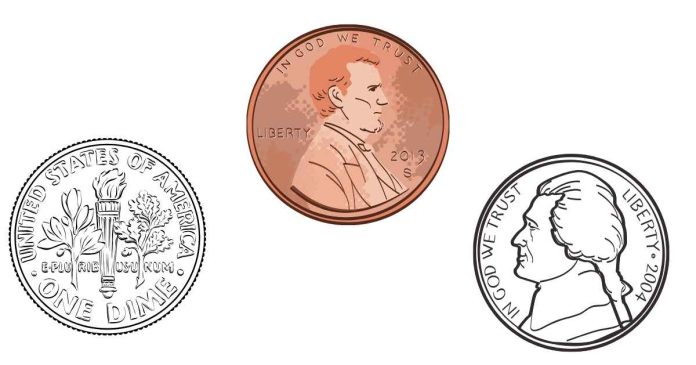The penny, nickel, and dime are all coins used in the United States currency system, but they differ in their value, size, and composition:
1. Penny
- Value: 1 cent ($0.01)
- Size: 0.75 inches (19.05 mm) in diameter
- Weight: 2.5 grams
- Composition: Primarily made of copper-plated zinc (97.5% zinc and 2.5% copper)
- Appearance: The penny features Abraham Lincoln on the obverse (front) and the Lincoln Memorial on the reverse (back), though newer versions show a shield design.
2. Nickel
- Value: 5 cents ($0.05)
- Size: 0.83 inches (21.21 mm) in diameter
- Weight: 5 grams
- Composition: Primarily made of a mixture of nickel and copper (75% copper and 25% nickel)
- Appearance: The nickel has Thomas Jefferson on the obverse and Monticello (Jefferson’s home) on the reverse.
3. Dime
- Value: 10 cents ($0.10)
- Size: 0.705 inches (17.91 mm) in diameter (smallest U.S. coin)
- Weight: 2.268 grams
- Composition: 91.67% copper and 8.33% nickel
- Appearance: The dime features Franklin D. Roosevelt on the obverse, and the reverse depicts a torch, olive branch, and oak branch.
Key Differences:
- Value: The penny is worth 1 cent, the nickel is worth 5 cents, and the dime is worth 10 cents.
- Size: The penny is the largest in diameter, followed by the nickel, and the dime is the smallest.
- Weight: The penny is the lightest, while the nickel is heavier than the penny, and the dime is the lightest after the penny.
- Composition: The penny has the most copper content, the nickel has a higher proportion of nickel, and the dime is mostly copper with a small amount of nickel.
These differences make each coin easily distinguishable by touch, size, and value.


